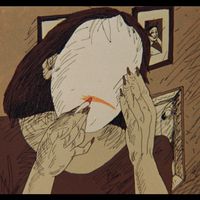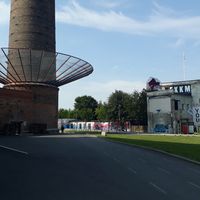East Toonia
| March 22nd 2007 will remain as an important day for the Estonian animation film industry. It was marked with a sad news; the pass-away of Elbert Tuganov, the father of the Estonian puppet animation, and with a great news that came on the same day; the awarding with the Grand-prix of the Latvian Bimini Animation Film Festival to an Estonian puppet animation. Sorrow and Joy have met last spring, announcing in a symbolic way, that Eesti Nukufilm – the Estonian Puppet Films studio, will officially celebrate its 50th anniversary this coming November. These simultaneous key-points in the history of the Estonian animation give us an opportunity to talk about the evolution of puppet motion films – a veteran film-genre, which in Estonia survived to the collapse of the Soviet Union and, succeeded to find its own way in the country’s new political | Courtesy by Estonian Joonisfilm studio. |
and economical landscape. Isn’t remarkable indeed, that a puppet film studio continues to present and win prizes at International festivals, even though the genre is marginally distributed in the world and, that on the funding-side, the local industry is in a transitional process after the country’s recent integration to EURIMAGE and MEDIA?
In a couple of days from now, another recent Nukufilm by Riho Unt - one of the Estonian leading animation film-masters will be presented at IndieLisboa, and Estonia will also participate later to the Annecy Film Festival competitions.
How could an Estonian puppet-film studio survive to opposite forces such as; the Soviet censorship first, and the globalization anarchy later? The answers to the question is now even more relevant that the“INSTITUTE OF THE DREAM” produced by Nukufilm was honored with the Latvian festival Grand Prix.
Breathing Space and New Colors
The decease of Elbert Tuganov at the age of 87 brings us back to the creation of the studio at a time where it had to serve the entertainment needs of a vast territory controlled by the Moscow Soviet ideology. The "LITTLE PETER’S DREAM" (1957), the first production to come out of the Tallinn films workshops paved the way for the abundant production of a studio that distinguished itself from most of the others Soviet studio’s with a first-class working structure – the Nukufilm. It is important to remember that at the time of its creation, Nukufilm started from the scratch with no organizational models to follow.
From its early days, the studio team tried to maintain a constant dynamic production by integrating new talents in the existing pools, and by developing bridges of cooperation between the different artistic departments within the studio. This strategy brought soon unexpected results; Tallinn animation films became a sort of “label” in a vast empire, which tried to homogenize its nations rather than marking the differences among them.
From Bulgaria to Mongolia, people enjoyed the animation films produced in Estonia, which were graphically different than most of the films made in the Soviet Union. In an article published by the Animation World Network Elbert Tuganov spoke about these differences of styles that made Estonian films originals. Estonian animation gave to the audience breathing space and different color tones. This composition-style differed also from the Scandinavian design. It was a mature conception of what the animation art should and should not do.
Is the rule still valid? If we consider today’s increasing success of Pocoyo the Spanish pre-school animated TV series; we have to admit that the ingredients are the same - breathing space and new color tones! Elbert’s approach can be applied to a modern production, Pocoyo is loved by millions from Japan to the Arabic countries for its unique clear and clean style.
The level of emptiness suggested by the founder of Nukufilm varied all along the studio’s productions. The latest awarded “THE INSTITUTE OF THE DREAMS” by Mati Kütt also want have much to see with Pocoyo. Nevertheless, it is this unique Estonian-way of using the colors and the space on the screen that decided the Hiroshima International Animation Festival, 2000 to bestow the Special International Jury Prize to Pritt Tender, from the new Estonian generation of animation films director at Joonisfilm studio.
In Tallinn as in the other parts of the world, the success of a generation seems always coming from the best balance between the observance of a taught model and the freedom it has to express its difference with the older generation. In other words, it is a question of breathing-space and new colors.
Goodbye Elbert!
RELATED
VHS on Estonian animated film can be purchased on the website
“Having Soul - 45 years of Nukufilm studio” by Chris Robinson, the artistic director of the Ottawa International Animation Festival
Spring 2007 in Tallinn gave a unique opportunity to talk about these elements that make Estonian and Japanese animation films different and similar sometimes. A colorful overview of Japanese anime allowed the Estonian audience discovering 15 full-length and five shorts made during the last 45 years. The films that have been presented in Tallinn, Narva and Rakvere constituted the programme of what is now called Estonia 1st Japanese Anime Festival (in ESTONIAN only).
Similar content
posted on
09 May 2011
posted on
26 Feb 2014
from - to
26 Nov 2016 - 27 Nov 2016
01 Jun 2018
posted on
03 Sep 2010
posted on
15 Jun 2010





